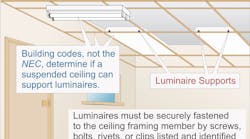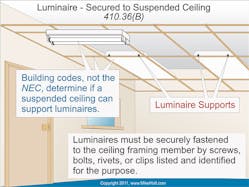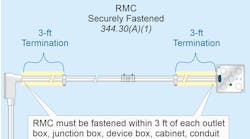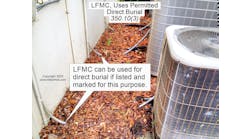Q. What means of support does the Code allow for luminaires?
Find the Answer
A. Outlet boxes designed for the support of luminaires must be supported by one of the following methods [410.36]:
• Fastened to any surface that provides adequate support [314.23(A)].
• Supported from a structural member of a building or from grade by a metal, plastic, or wood brace [314.23(B)].
• Secured to a finished surface (drywall or plaster walls or ceilings) by clamps, anchors, or fittings identified for the application [314.23(C)].
• Secured to the structural or supporting elements of a suspended ceiling [314.23(D)].
• Supported by two intermediate metal conduits or rigid metal conduits threaded wrench tight [314.23(E) and (F)].
• Embedded in concrete or masonry [314.23(G)].
• Outlet boxes for luminaires can support a luminaire that weighs up to 50 lb, unless the box is listed for the luminaries’ actual weight [314.27(A)(2)].
If framing members of suspended-ceiling systems are used to support luminaires, they must be securely fastened to each other, and they must be securely attached to the building structure at appropriate intervals. Luminaires must be attached to the suspended-ceiling framing members with screws, bolts, rivets, or clips that are listed and identified for such use [410.36(B)] (see Figure).
Note: The NEC doesn’t require independent support wires for suspended-ceiling luminaires that aren’t installed in a fire-rated ceiling; however, building codes often do. In addition, raceways and cables within a suspended ceiling must be supported in accordance with 300.11(A). Outlet boxes can be secured to the ceiling-framing members by bolts, screws, rivets, clips, or independent support wires that are taut and secured at both ends [314.23(D)].
Trees can be used to support luminaires, but they must not be used to support overhead conductor spans [225.26 and 410.36(G)].





